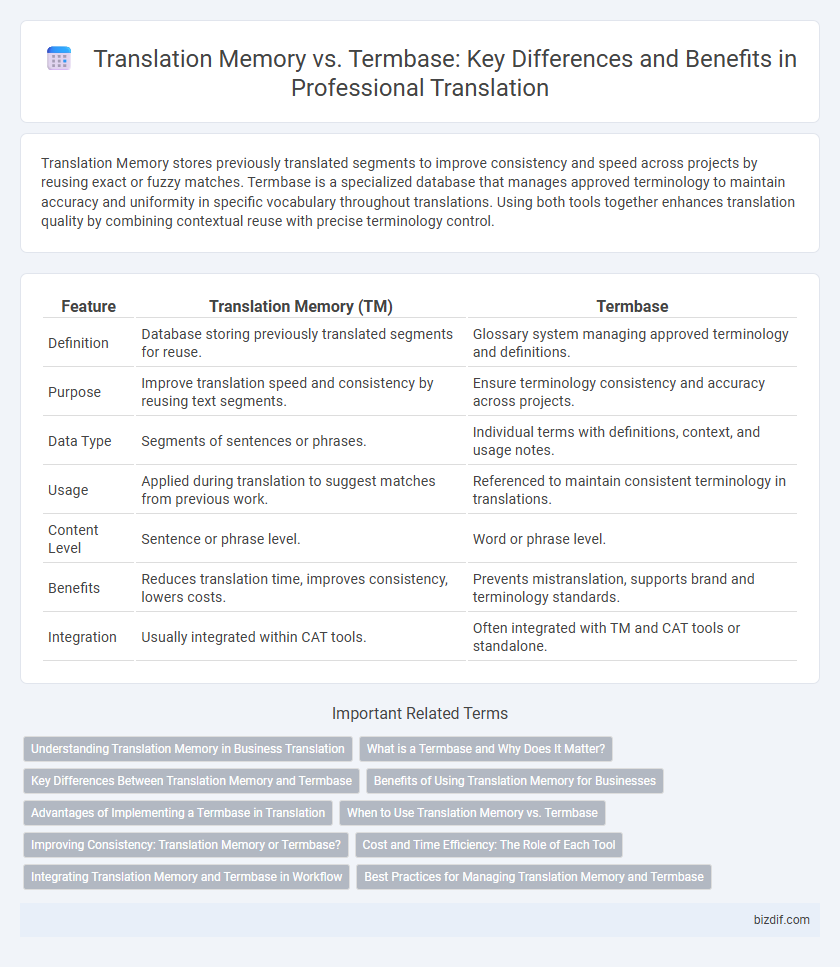Translation Memory stores previously translated segments to improve consistency and speed across projects by reusing exact or fuzzy matches. Termbase is a specialized database that manages approved terminology to maintain accuracy and uniformity in specific vocabulary throughout translations. Using both tools together enhances translation quality by combining contextual reuse with precise terminology control.
Table of Comparison
| Feature | Translation Memory (TM) | Termbase |
|---|---|---|
| Definition | Database storing previously translated segments for reuse. | Glossary system managing approved terminology and definitions. |
| Purpose | Improve translation speed and consistency by reusing text segments. | Ensure terminology consistency and accuracy across projects. |
| Data Type | Segments of sentences or phrases. | Individual terms with definitions, context, and usage notes. |
| Usage | Applied during translation to suggest matches from previous work. | Referenced to maintain consistent terminology in translations. |
| Content Level | Sentence or phrase level. | Word or phrase level. |
| Benefits | Reduces translation time, improves consistency, lowers costs. | Prevents mistranslation, supports brand and terminology standards. |
| Integration | Usually integrated within CAT tools. | Often integrated with TM and CAT tools or standalone. |
Understanding Translation Memory in Business Translation
Translation Memory (TM) stores previously translated segments to improve consistency and efficiency in business translation projects. It helps translators reuse exact matches and similar phrases, reducing turnaround time and costs while maintaining terminology accuracy. TM is essential for managing large-scale multilingual content, ensuring uniformity across all communication materials.
What is a Termbase and Why Does It Matter?
A termbase is a specialized database that stores approved terminology and linguistic information for consistent and accurate translation across projects. It ensures uniform use of industry-specific terms, enhancing quality and reducing errors in multilingual content. Maintaining a termbase is essential for terminological accuracy and aligning translations with brand or client-specific language standards.
Key Differences Between Translation Memory and Termbase
Translation Memory stores previously translated sentence segments to facilitate consistent reuse and speed up the translation process, while Termbase contains specialized terminology and definitions to ensure accurate and standardized use of key terms. Translation Memory operates at the sentence or phrase level, enabling translators to leverage past work for efficiency, whereas Termbase functions at the word or phrase level, maintaining terminological consistency across documents. Both tools enhance translation quality but serve distinct purposes: Translation Memory improves overall workflow efficiency, and Termbase ensures terminological precision.
Benefits of Using Translation Memory for Businesses
Translation Memory enhances consistency and efficiency by storing previously translated segments, enabling businesses to quickly reuse accurate translations in future projects. This reduces turnaround times and lowers costs while maintaining brand voice and terminology across all content. Leveraging Translation Memory also improves collaboration among linguists by providing a centralized repository of approved translations.
Advantages of Implementing a Termbase in Translation
Implementing a termbase in translation enhances consistency by providing a centralized repository of approved terminology, which streamlines multilingual projects and reduces errors. It enables quicker decision-making and improves quality assurance through standardized language use specific to client or industry requirements. Utilizing a termbase also boosts productivity by minimizing repeated research and accelerating the translation workflow for specialized content.
When to Use Translation Memory vs. Termbase
Translation Memory (TM) is most effective for reusing previously translated segments in large projects with repetitive content, speeding up translation and ensuring consistency. Termbase excels in managing specialized vocabulary and terminology accuracy across multilingual documents, particularly in technical or legal fields. Use TM for sentence-level repetition and Termbase for maintaining precise terminology and standardized language use.
Improving Consistency: Translation Memory or Termbase?
Translation memory improves consistency by storing previously translated sentence segments, ensuring repeated phrases remain uniform across projects. Termbases provide standardized, approved terminology, preventing variation in specific terms within a language pair. Combining translation memory with a termbase maximizes accuracy and maintains cohesive style throughout multilingual content.
Cost and Time Efficiency: The Role of Each Tool
Translation Memory enhances cost and time efficiency by storing previously translated segments, enabling quick reuse and reducing repetitive work for translators. Termbase maintains consistency and accuracy by managing specialized vocabulary and terminology, minimizing costly errors and revisions. Combining both tools optimizes workflow, cutting translation costs and shortening project timelines significantly.
Integrating Translation Memory and Termbase in Workflow
Integrating Translation Memory (TM) and Termbase in the translation workflow enhances consistency and efficiency by leveraging stored bilingual segments alongside curated terminology databases. Utilizing TM ensures repeated phrases are translated uniformly, while real-time access to termbases maintains accurate use of domain-specific vocabulary. This combination reduces post-editing time and improves overall translation quality by harmonizing linguistic resources within a single integrated system.
Best Practices for Managing Translation Memory and Termbase
Effective management of Translation Memory (TM) and Termbases requires regular updates and consistent quality checks to ensure accuracy and relevance. Implement structured workflows that integrate TM and Termbase maintenance, including periodic audits and validation by linguistic experts. Leverage automation tools to streamline term extraction and duplication elimination while maintaining context-specific consistency across translation projects.
Translation Memory vs Termbase Infographic

 bizdif.com
bizdif.com